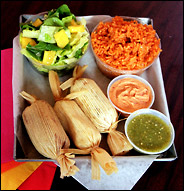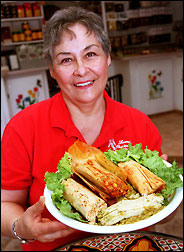|
 |
|
Esta página no está disponible en español. THE NEW YORK TIMESTamales Are Hot, As In PopularBy ELAINE LOUIE
MAY 22, 2002 PHOTOS: Cary Herz for The New York Times
EARLY every night, the phone rings at Zarela, the Mexican restaurant in midtown Manhattan, and it is a customer with a specific question. What is the tamal of the day? It might be pork in a mole of chocolate, ground hazelnuts, almonds, pecans, peanuts, roasted onions and tomatoes. It could be chicken with a delicately spicy tomatillo sauce. "Most of those who call are Americans," said Zarela Martínez, the owner, who estimates that she sells about 500 tamales a week. Three years ago, it was half that. Across the Hudson River in Hoboken, Maricel Presilla, an owner of Zafra, a two-year-old Pan-Latin restaurant, fields the same daily question. "Some ask for the Cuban ones," Ms. Presilla said of tamales made with fresh corn and seasoned with a sauté of onions, peppers, garlic and tomatoes. "Some ask for humitas from Chile, yellow corn with basil." To anyone who has ever slipped off the corn husk wrapper of a tamal (tamales is the plural), inhaled the steamy scent of corn and dipped into the tender masa, or corn dough, wrapped around morsels of braised chicken or pork, the appeal of tamales is clear. Soft and fluffy with a hint of spice, they are made to be untied and unwrapped, like small gifts. --------------- Tamales, the ancient Aztec meal of corn dough wrapped in leaves and steamed, were once relegated to special occasions, even in Mexican restaurants. These days they are a delicacy for everyday, fast encroaching on the territory once held by the enchilada on menus. Aficionados have favorite Web suppliers; savvy specialty shops stock several kinds. "Tamales are going mainstream, like ceviche and dulce de leche," Ms. Presilla said. In February of last year, Erin Wood started Tamale Molly, a company in Santa Fe, N.M., that makes only vegetarian tamales. She now has daily sales of about 1,500 — pine nut with Monterey Jack cheese, cilantro and green chili, and vegan varieties like black bean with chipotle chili. She serves some up in her cafe, but about 80 percent are sold wholesale, shipped frozen to stores like Whole Foods in Colorado and Kansas and United Market Street in Texas. Goya, the Latin American food company, introduced a line of tamales in 1987 that now consists of Puerto Rican, Cuban and Mexican styles, with Peruvian and Ecuadorean versions in experimental stages. "Since 1999, we have doubled the retail sales, from around 50,000 tamales a year to 100,000," said Lydia Cantú, a marketing manager at Goya. "The Hispanic population is growing, and this is attracting non-Hispanics to the Hispanic foods," she said. According to the census, in 2000 more than 35 million people defined themselves as Hispanic, about 12.5 percent of the population, up from around 22 million, or 9 percent, in 1990. With her vegetarian tamales, Ms. Wood has found a niche market. "We're treating them as a ready-to-eat, ready-to-heat entree, an option as opposed to lasagna," she said. "We're not considering ourselves a Mexican food product." Ms. Wood runs her company as a nonprofit business. She expects to donate $10,000 to $20,000 next year to the Food Depot, a food bank in Santa Fe. The tamales of Mexico, Honduras and Colombia become pasteles in Puerto Rico and hallacas in Venezuela. They are called humitas, a word in Quechua, the language of the Incas, in Chile, Peru, Argentina, Ecuador and Bolivia. In Nicaragua, they are nacatamales, and in Brazil, pamonhas. "Nearly everybody uses some form of corn, whether fresh or dried, treated with lime or not," said Ms. Presilla, the author of a Pan-Latin cookbook to be published next year by W. W. Norton. A history of the Aztecs written in the 16th century by Bernardino de Sahagún, a priest, tells of tamales stuffed with fruit, honey, even bees. Sophie D. Coe, in "America's First Cuisines" (University of Texas Press, 1999), quotes Father Sahagún's description of a tamal vendor: "He sells meat tamales, turkey meat packets, plain tamales, tamales with chili, . . . frog tamales, pocket gopher tamales: tasty — tasty, very tasty." Today, tamales are found tinted pale orange by annatto seeds, or striated beige and brown, when the filling has been daubed with a mole sauce. There are Puerto Rican pasteles made of mashed plantains, with a faint yellow-green cast. "There are also pasteles de arroz, made of cooked rice, raw yucca, a sofrito and pork," said Douglas Rodriguez, the chef and owner of Chicama, the Pan-Latin restaurant in Manhattan. Tamales can be as slender as a cigar, or as plump as a fist. Mr. Rodriguez has eaten hallaquitas, tiny versions of hallacas, that are only two inches long. "Snack size," Mr. Rodriguez said. "Three bites." The Colombian version, available at Tierras Colombianas in Queens, is a 10-ounce one-dish meal of masa, pork, chicken, potatoes, onions and carrots wrapped in a plantain leaf. In Mexico, there are tamales called zacahuiles that are five feet in length, enclose a haunch of pork and have to be transported in pickup trucks, Ms. Martínez said. A tamal can be a simple, smooth rectangle of masa — the corn moistened with broth and made fluffy with a bit of lard — with no filling at all, and a sauce on the side, or not. But not all tamales are savory. "There are also ones with sugar or with a little ground pineapple," said the chef Rick Bayless, who with his wife, Deann, owns Frontera Grill and Topolobampo in Chicago. Enthusiasts fall into two camps, the traditional and the nouvelle. The traditionalists include Ms. Martínez, Ms. Presilla and the Baylesses, who make tamales whose flavors — mole sauce, chicken poached with onions, cumin and oregano — are ancient and familiar. They improvise by using less lard and more broth for a lighter, less cholesterol-laden masa. Mr. Bayless has made a Oaxacan tamal with clams and a shrimp-stuffed tamal with ancho chili. "I haven't yet exhausted all the traditional tamales," Mr. Bayless said. "There are thousands." Ms. Martínez said: "Sometimes if it's an American chef, they'll put everything, including the kitchen counter, in there. Or they will misguidedly use butter or oil." Ms. Wood, of course, doesn't feel misguided at all when she substitutes butter for lard, and for her vegan tamales, uses olive oil. Traditionally, tamales were a holiday dish. "They were made for Christmas, a festival in the town, a family reunion," said Francisco Gutierrez, a pastry cook at Le Cirque 2000. Ms. Martínez has mixed feelings about idiosyncratic tamales. Nouvelle chefs, she said "are bringing tamales to mainstream life, but tamales are such a ritualistic food; I hope the ritual is preserved." It may be too late for that. Once, making tamales was a communal event, with the whole family filling and wrapping, telling stories and singing songs. There is even a word for it in Spanish, tamalada. Now there are Hobart mixers to make and aerate the masa, pressure cookers for quickly cooking pork and chicken, and aluminum foil and plastic bags to seal the tamales for freezing. They can be flown anywhere, safe in their FedEx boxes. Leona Medina, the 60-year-old cook and owner of Leona's Restaurante de Chimayo in Chimayo, N.M., knows that. She started her restaurant in 1976 across the street from the 1812 Santuario de Chimayo, a church that draws 55,000 pilgrims yearly during Holy Week. She sells 400 to 500 tamales a week, fresh or frozen. "The recipes were handed down to me from my mother," she said. Mr. Rodriguez segues easily from old to new. "I invented a tamal in a large clam shell," he said, stuffed with masa, chopped parsley, garlic, tomato, oregano and quahog clam. Then he wraps the shell in plastic wrap and steams it. Mr. Bayless dismissed the trend toward nouvelle tamales, saying, "It's chocolate cake batter in a corn husk." He sighed. "But who's to say what tamales can evolve into?"
|

 ---------------
---------------